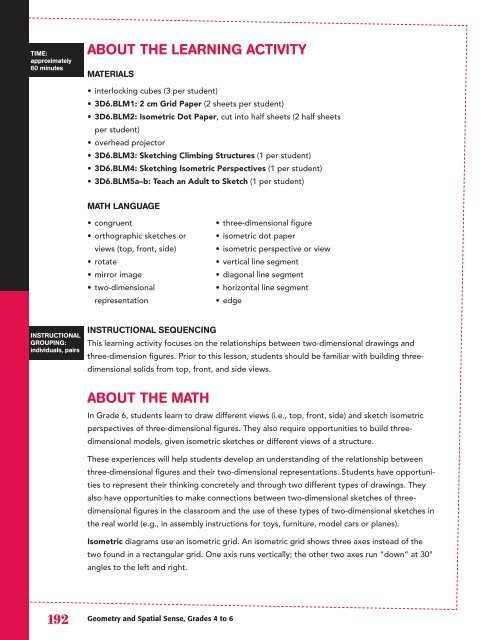Geometry and Spatial Sense, Grades 4 to 6 - EduGains
Geometry and Spatial Sense, Grades 4 to 6 - EduGains
Geometry and Spatial Sense, Grades 4 to 6 - EduGains
You also want an ePaper? Increase the reach of your titles
YUMPU automatically turns print PDFs into web optimized ePapers that Google loves.
TIME:<br />
approximately<br />
60 minutes<br />
INSTRUCTIONAL<br />
GROUPING:<br />
individuals, pairs<br />
1 2<br />
ABOUT THE LEARNING ACTIVITY<br />
MATERIALS<br />
• interlocking cubes (3 per student)<br />
• 3D6.BLM1: 2 cm Grid Paper (2 sheets per student)<br />
• 3D6.BLM2: Isometric Dot Paper, cut in<strong>to</strong> half sheets (2 half sheets<br />
per student)<br />
• overhead projec<strong>to</strong>r<br />
• 3D6.BLM3: Sketching Climbing Structures (1 per student)<br />
• 3D6.BLM4: Sketching Isometric Perspectives (1 per student)<br />
• 3D6.BLM5a–b: Teach an Adult <strong>to</strong> Sketch (1 per student)<br />
MATH LANGUAGE<br />
• congruent<br />
• orthographic sketches or<br />
views (<strong>to</strong>p, front, side)<br />
• rotate<br />
• mirror image<br />
• two-dimensional<br />
representation<br />
INSTRUCTIONAL SEqUENCING<br />
<strong>Geometry</strong> <strong>and</strong> <strong>Spatial</strong> <strong>Sense</strong>, <strong>Grades</strong> 4 <strong>to</strong> 6<br />
• three-dimensional figure<br />
• isometric dot paper<br />
• isometric perspective or view<br />
• vertical line segment<br />
• diagonal line segment<br />
• horizontal line segment<br />
• edge<br />
This learning activity focuses on the relationships between two-dimensional drawings <strong>and</strong><br />
three-dimension figures. Prior <strong>to</strong> this lesson, students should be familiar with building three-<br />
dimensional solids from <strong>to</strong>p, front, <strong>and</strong> side views.<br />
ABOUT THE MATH<br />
In Grade 6, students learn <strong>to</strong> draw different views (i.e., <strong>to</strong>p, front, side) <strong>and</strong> sketch isometric<br />
perspectives of three-dimensional figures. They also require opportunities <strong>to</strong> build three-<br />
dimensional models, given isometric sketches or different views of a structure.<br />
These experiences will help students develop an underst<strong>and</strong>ing of the relationship between<br />
three-dimensional figures <strong>and</strong> their two-dimensional representations. Students have opportuni-<br />
ties <strong>to</strong> represent their thinking concretely <strong>and</strong> through two different types of drawings. They<br />
also have opportunities <strong>to</strong> make connections between two-dimensional sketches of three-<br />
dimensional figures in the classroom <strong>and</strong> the use of these types of two-dimensional sketches in<br />
the real world (e.g., in assembly instructions for <strong>to</strong>ys, furniture, model cars or planes).<br />
Isometric diagrams use an isometric grid. An isometric grid shows three axes instead of the<br />
two found in a rectangular grid. One axis runs vertically; the other two axes run “down” at 30°<br />
angles <strong>to</strong> the left <strong>and</strong> right.

















